This was published 5 years ago
Swansea, Wales travel guide: Tour of poet Dylan Thomas's Wales
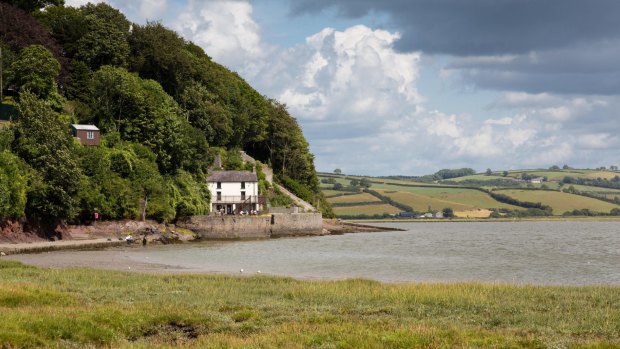
The Boathouse at Laugharne, the famous home of Dylan and Caitlin Thomas.Credit: Alamy
"To begin at the beginning. It is Spring, moonless night in the small town, starless and bible-black, the cobblestreets silent and hunched, courters'-and-rabbits' wood limping invisible down to the sloeblack, slow, black, crow black, fishingboatbobbing sea." - Under Milk Wood.
To begin at the end, Dylan Thomas – arguably the greatest English language poet of the 20th century – died in New York in 1953 after a heavy drinking session during a sell-out recital tour of the US.
According to the now discredited legend, his last known words were: "I've just drunk 18 straight whiskies…I think that's a record."
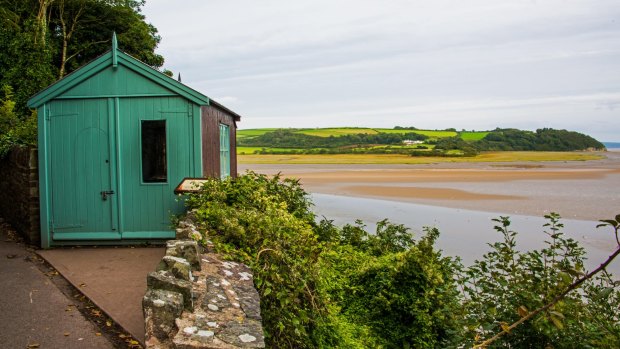
Dylan Thomas's writing shed.Credit: Alamy
In fact the 39-year-old remained comatose in hospital while his wife Caitlin flew from their tiny home, the Boat House, in the Welsh fishing village of Laugharne to be at his deathbed.
Her first words to her permanently pickled, philandering, penniless husband after flying all that way? "Is the bloody man dead yet?"
To be fair, she later excused herself on account of being "blind drunk" herself at the time.
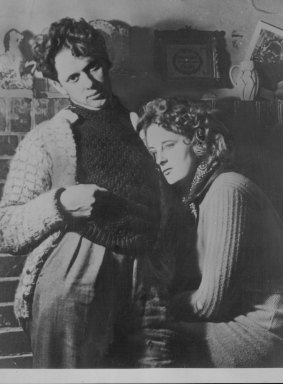
Dylan and Caitlin in 1965, shortly after their marriage.Credit: Fairfax Media
Their relationship – which produced three children, endless infidelities (on both sides) and a shared lover in Caitlin's best girlfriend – was shambolic, chaotic and alcoholic.
Yet it endured because of their love for each other.
When Dylan Thomas died there was no money for a headstone, so his grave at Laugharne's St Martin's churchyard is marked by a simple white-painted wooden cross with his name on it.
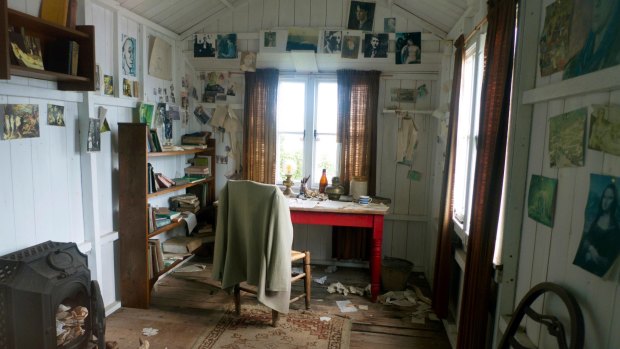
Inside Dylan Thomas' writing shed in on the Taf Estuary in the village of Laugharne.Credit: Alamy
When Caitlin (a talented writer herself) died in 1994 in Italy (after giving birth to a fourth child when she was 49 to her much younger lover) her will stipulated she be buried with Dylan.
It remains a single (and surprisingly silent) "pauper's plot", but her name adorns the other side of their mutual cross.
Dylan described Laugharne (pronounced "Larne") as "the strangest town in Wales" and "timeless, beautiful, barmy".
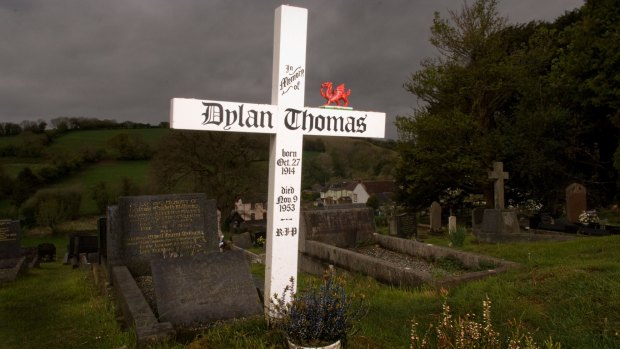
Dylan Thomas' grave.Credit: Alamy
Much of his masterpiece, Under Milk Wood, was written in the wooden garage in the back lane above the Boat House which the poet used as his "writing shed" (the family had no money for a car).
On this perfect spring morning, the beachside path, now called Dylan's Walk – a 10-minute stroll from Laugharne Castle to the Boat House – is thriving. Most are locals, pushing prams or walking dogs. The rest – like me – are here to gawp.
Could such beautiful poetry have emerged from such a bitter, traumatic marriage?
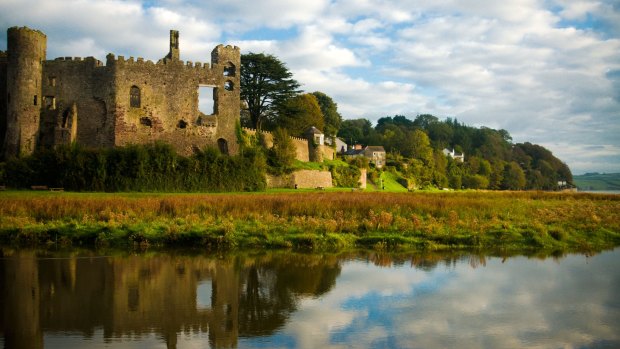
Laugharne castle in West wales with Dylan Thomas' Boathouse in the distance.Credit: Alamy
Did Dylan and Caitlin really spend their golden years in a two-up, two-down cottage with an outside loo and no electricity?
(Though the Boat House was the first property in Laugharne to have running water, courtesy of Dylan's patroness, actress Margaret Taylor – wife of the historian AJP Taylor who detested him).
Today the Boat House ("my seashaken house on a breakneck of rocks") is a memorial to both Dylan and Caitlin, one of the most evocative literary homes in Britain.
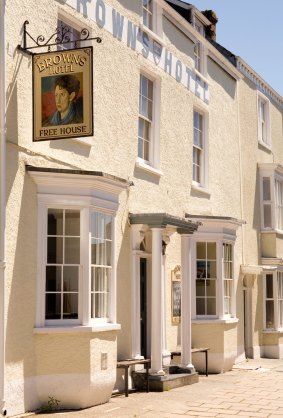
Brown's Hotel, Dylan Thomas' favourite pub.Credit: Alamy
The downstairs room where Llewelyn – their oldest son (who changed his name to Tom Llewelyn to avoid conversations about his father) slept – is now the museum entrance and gift shop.
Next door is the sitting room where the family gathered when Dylan and Caitlin were in harmonious moods. It's now decorated with precious Dylanabilia.
Yet the radio, booming with Dylan's theatrical voice narrating his own works, is the highpoint.
Under Milk Wood ("a play for voices") was first broadcast in 1954, the year after he died.
His friend and fellow Welsh drunkard Richard Burton recited the lines Dylan had written for himself.
Before the age of television, let alone the internet, radio was the medium of the future. And Dylan Thomas (like Churchill and FDR) was a master of the radio art. Perhaps no other poet in human history has left such a vocal record of how their works should be performed.
The origin for this goes back to Swansea.
Dylan Marlais Thomas was born in 1914 and raised in the middle-class suburb of Uplands at 5 Cwmdonkin Drive, Swansea.
Dylan, an only son, was indulged. His father was a notoriously strict English teacher at Swansea Grammar School.
Yet Dylan was a terrible pupil (though he did win the school's mile race despite his asthma – carrying the newspaper cutting of his victory in his wallet until the day he died).
He skipped school often, leaving formal education at 16 to become a junior reporter at the South Wales Daily Post.
If you're in Swansea ("an ugly lovely town"), your first port of call should be the Dylan Thomas Centre at the former 19th Century Guildhall on the city's historic dockside.
It provides a superb overview of the poet's life and career, and is the starting point for a short literary walk which encompasses eight places with significant connections: his old school, the BBC studios where he recorded some of his early "hits", Swansea Museum which he frequented as a truant, and the various pubs where he was a regular.
If you can visit just one, walk five minutes to Wind Street to the No Sign Wine Bar, reputedly the oldest pub in Swansea, dating back to the 15th century. You'll find it on the corner of the ironically named Salubrious Passage.
There's a statue of the poet (looking remarkably like Martin Freeman in The Hobbit) outside the Dylan Thomas Theatre. He never performed here, but perfected that unforgettable, melodious voice at the Swansea Little Theatre's home in Mumbles, the swish seaside resort on the nearby Gower Peninsula.
The pilgrimage (via a bus ride) will also take you to Uplands. Yes, you can see the blue plaque over 5 Cwmdonkin Drive and the Uplands Hotel (now Tavern) where he celebrated after writing his first poems (75 per cent of his poetry was written between the ages of 16 and 23 – including the prophetic Death Shall Have No Dominion).
However Cwmdonkin Park – "the world within the world of the sea-town" – inspired Thomas for the rest of his life, as did his visits to Uplands Cinema (now a bank).
Too "unhealthy" to serve in the front line, Thomas spent WWII writing propaganda movies, publishing new poetry, having affairs, and developing the skill that he became master of: radio theatre.
He and Caitlin had lived in Laugharne at a terraced cottage called Sea View (behind the castle) in the years before WWII, before they were forced to flee because of his bad debts. And they returned in 1949 when Margaret Taylor bought the Boat House for them.
He moved his parents to Laugharne, renting a house opposite his favourite pub, Brown's Hotel. Father and son spent most mornings doing the crossword together, before Dylan retired to his writing shed. Brown's now hosts a regular "poetry and pints" night.
Dylan wrote much of his best work in Laugharne, most notably Under Milk Wood – set in the fictional fishing village of Llareggub (BuggerAll, spelt backwards). He was performing excerpts from his "play for voices" when he died.
Yet today his most quoted work is the poem he wrote when his own father was dying.
"Do not go gentle into that good night,
Old age should burn and rave at close of day;
Rage, rage against the dying of the light."
TRIP NOTES
MORE
traveller.com.au/wales
visitwales.com
VISIT
The Boathouse, now a museum, lies on the Wales Coast Path – dylanthomasboathouse.com
The Dylan Thomas Centre, Swansea – swansea.gov.uk/dtc.
Dylan Thomas walking trails of Wales – dylanthomas.com/dylan-thomas-trails
FLY
Qatar Airways flies from several Sydney, Melbourne, Brisbane and Canberra to Cardiff, via Doha – qatarairways.com
Steve Meacham travelled as a guest of Qatar Airways and Visit Wales.
Sign up for the Traveller Deals newsletter
Get exclusive travel deals delivered straight to your inbox. Sign up now.